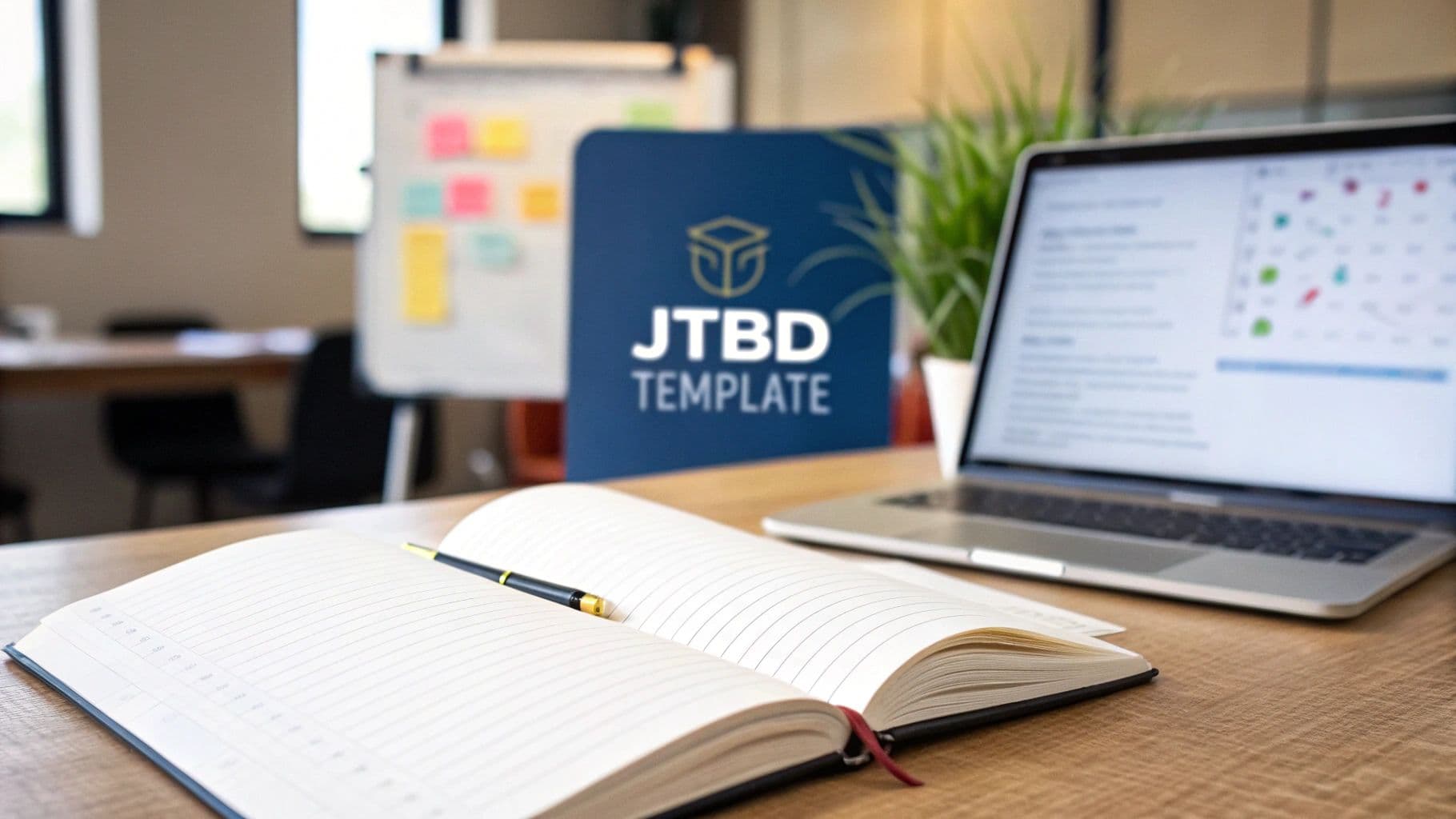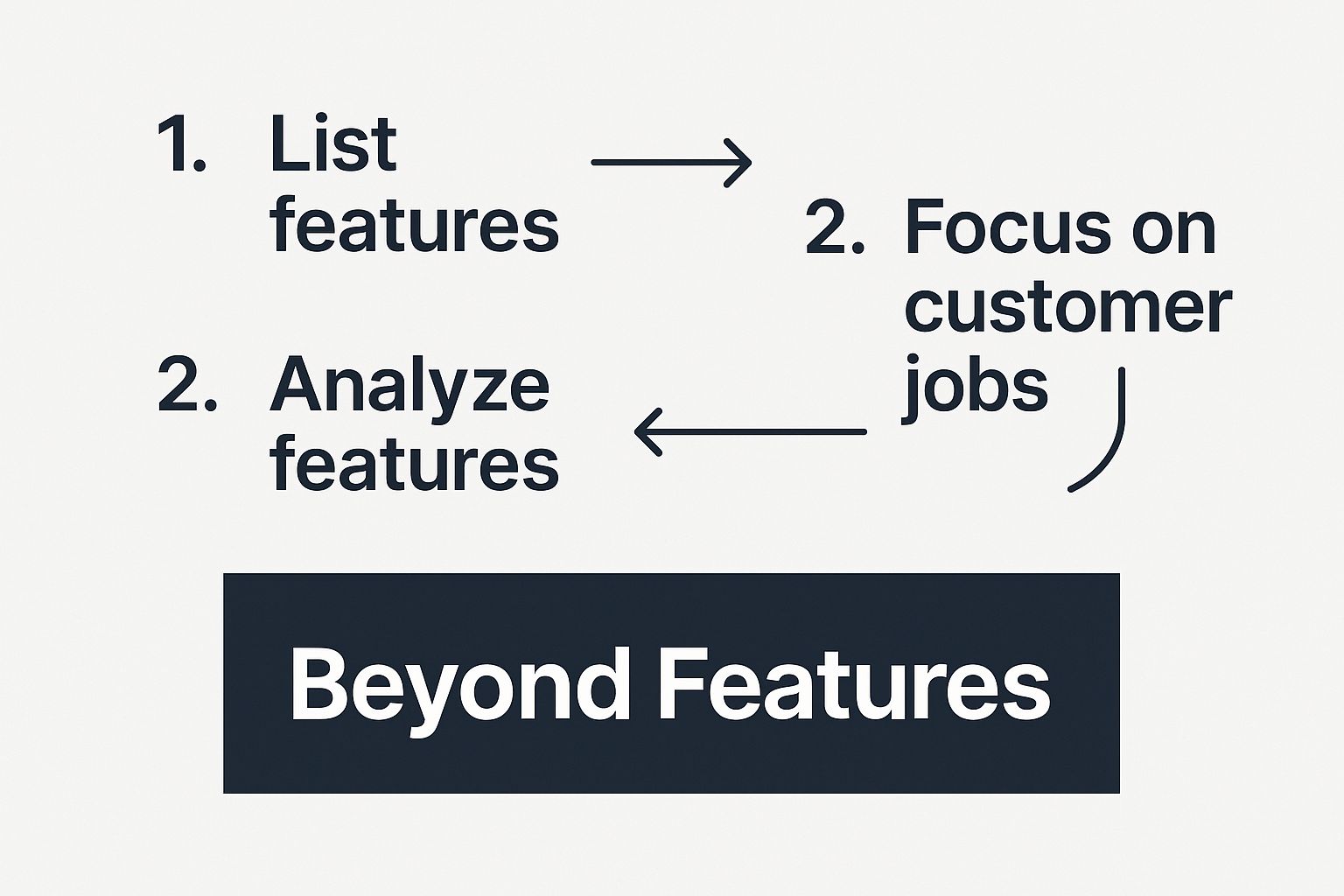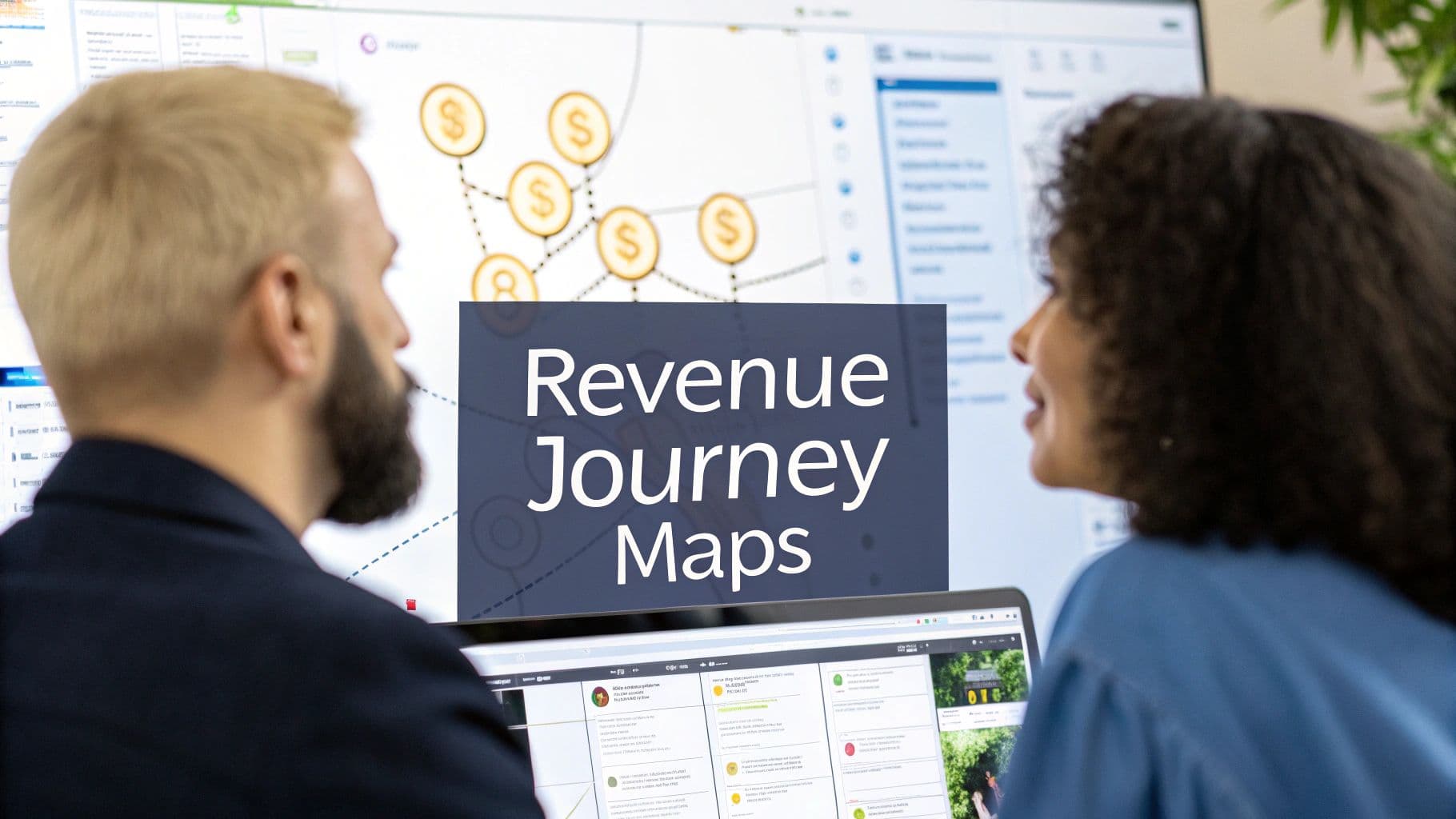Your Essential Jobs To Be Done Template
Download our Jobs to be Done template and discover how to truly understand your customers. A practical guide with real examples for product teams.

A Jobs-to-Be-Done (JTBD) template is a powerful, yet surprisingly simple, tool that helps product teams figure out why a customer truly chooses a product. It’s all about shifting your focus from building features to solving the core problem—the "job"—a customer is trying to get done. Think of it as your roadmap to understanding what actually motivates your users.
Moving Beyond Features With a JTBD Template
It’s easy for product teams to fall into the feature-factory trap. You know the one: endlessly adding more and more features, hoping the next update will finally be the one that makes users happy. But that approach often misses the mark completely. The Jobs-to-Be-Done framework flips this on its head with a simple but game-changing idea: customers don't buy products; they "hire" them to make progress in their lives.
Let’s take a real-world example. Someone using a podcast app during their morning commute isn't just hiring it to play audio files. They're hiring it to make their drive feel more productive, to learn something new, or maybe just to tune out the stress of rush-hour traffic. That's the real "job."
This change in mindset helps you get to the heart of customer needs, moving way beyond a simple feature list. It forces you and your team to dig into the user's underlying struggle and what they see as a successful outcome. This kind of insight is pure gold for effective market research for product development, because it ensures you're building solutions for actual problems.
The infographic below really brings this shift to life, showing how you can move from a feature-first mindset to focusing on the customer's actual job.

This visual is a great reminder of how JTBD helps teams see past surface-level functions to uncover the real progress a customer is trying to make.
Why This Perspective Matters
Looking through a JTBD lens isn't just a mental exercise—it delivers real business results. The framework, first formalized by Clayton Christensen, helps companies align their innovation efforts with what customers actually value. In fact, some companies that have adopted JTBD principles have seen sales increases of up to 25% by getting better at meeting customer needs. This framework gives you a clearer path to understand customer needs in a way that truly drives growth.
When you focus on the job, you gain clarity that sharpens everything you do, from building your product roadmap to crafting your marketing messages. It gives you a stable target to aim for. After all, technologies and features change all the time, but the core jobs people need to get done often stay the same for years.
Putting Your Jobs-to-be-Done Template to Work
Alright, you've got the template. Now for the fun part: turning that blank canvas into a treasure map of customer insights. This is where we move past the theory and dig into the real-world struggles and goals that drive people to seek out new solutions.
To make this tangible, let's follow a single, relatable scenario. We'll use the example of a small business owner looking for accounting software. It’s a classic story filled with frustration, aspiration, and the desperate need for a better way. Let’s call our entrepreneur Alex, who runs a growing e-commerce shop and is currently drowning in a sea of spreadsheets.

Nailing the Core Job Statement
First things first, we need to define the Job Statement. This is the absolute heart of the framework. A common mistake here is to describe your product or a type of solution. You have to resist that urge. The real goal is to capture your customer's underlying motivation, completely separate from any product.
Think of it this way: a good Job Statement should be timeless and solution-agnostic.
For instance, a weak statement for Alex would be: "Alex needs new accounting software." That’s a solution, not a job.
A much, much better Job Statement would be: "Help me manage my business finances with confidence, so I can free up time to focus on growing my company."
See the difference? This one gets to the core of it. It lays out the functional goal (manage finances) and, just as importantly, the emotional payoff (confidence, more time). This is the real job Alex is "hiring" a solution to do.
What Are Their Desired Outcomes?
With the core job defined, we can now break it down into Desired Outcomes. These are the specific, tangible results the customer is hoping for. Think of these as their personal success metrics for the job. From their perspective, what does "done" and "done well" actually look like?
For Alex and his accounting software search, some of his desired outcomes might be:
- Reduce the time I waste on monthly bookkeeping by at least 50%.
- Minimize the risk of a costly tax filing error that keeps me up at night.
- Increase my real-time visibility into cash flow so I can make smarter inventory buys.
- Feel confident that my books are always accurate and organized.
These outcomes give your product team crystal-clear targets. If your features can move the needle on these specific metrics, you’re not just building another tool—you’re successfully doing the job for your customer.
Understanding the "Hire" and "Fire" Criteria
This next section of the jobs to be done template is where you get into the psychology of change. It’s all about the forces that push a customer toward a new solution and the anxieties that hold them back.
Hiring Criteria (The Push and The Pull)
These are the powerful forces that convince Alex it's time to hire something new.
- The Push: The catalyst. Alex just wasted an entire weekend fixing a spreadsheet error that almost caused him to under-order his best-selling product. The pain is real and immediate.
- The Pull: The promise of a better future. He sees an ad for a new accounting app that boasts automatic bank reconciliation and one-click invoicing. It sounds like a dream.
Firing Criteria (The Habit and The Anxiety)
These are the competing forces that make it hard for Alex to fire his old, broken process (those messy spreadsheets).
- The Habit: He’s used to his spreadsheet system, warts and all. It’s familiar, and learning a whole new tool feels like a lot of work.
- The Anxiety: The fear of the unknown. What if the new software is too complicated? What if he messes up migrating his data?
Nailing these four forces is mission-critical. Your marketing team's job is to amplify the push and the pull. Your product and design teams' job is to design an onboarding experience that crushes the anxiety and makes breaking the old habit feel effortless.
Gathering Insights That Actually Matter
A Jobs-to-be-Done template is only as good as the insights you put into it. If you're not fueling it with real customer stories, you're essentially just guessing and confirming your own biases. To get at the truth, you have to go beyond surface-level surveys and really understand the context and motivations driving people to your product.
The best place to start is with JTBD interviews. These aren't your typical feedback sessions. Think of them more like investigative journalism—you're trying to uncover the full story behind why a customer switched from one solution to another. The goal is to have them walk you through their entire journey, from the first flicker of frustration to the moment they decided to "hire" your product.
Uncovering the Real Story
The richest insights almost always come from open-ended questions that get people talking. Steer clear of questions about specific features. Instead, you want to get them talking about their experience and the progress they were desperate to make.
Here are a few of my go-to questions to get the conversation rolling:
- "Can you tell me about the last time you tried to [accomplish the core job]?"
- "What was the most frustrating part of that whole process?"
- "What else did you try before you landed on our solution? Any weird workarounds?"
- "Was there a 'last straw' moment that made you realize the old way wasn't cutting it?"
When you're deep in customer interviews, turning all that audio into text you can actually search and analyze is a huge help. Using a good auto transcribe software can make this part of the process way less painful, letting you connect the dots much faster.
Beyond the Interview
While interviews are the bedrock of JTBD research, they aren't the only place to find gold. You can uncover incredible insights in channels your team might be ignoring. For instance, a deep voice of customer analysis can highlight the recurring pain points that customers are already shouting about.
Don't forget to pull from these other sources:
- Contextual Inquiry: There's no substitute for seeing it yourself. Go watch users in their natural habitat. Seeing someone struggle with a task in their actual office or home provides a layer of context an interview simply can't capture.
- Support Ticket Mining: Your support desk is a treasure trove of JTBD data. Dig through tickets for recurring issues, emotional language, and detailed descriptions of the problems your product was hired to solve (and maybe fell short on).
- "Switch" Analysis: Make a point to talk to people who just signed up and people who just canceled. Understanding why someone "hired" you and why someone else "fired" you gives you the complete picture of the competing forces at play.
Turning Your JTBD Template Into Action
Alright, your Jobs-to-be-Done template is filled out. Fantastic. But right now, it's just data. The real magic happens when you turn that data into a strategic roadmap that guides your team toward real, impactful innovation. This is where you shift from just understanding the customer's world to actively solving their problems.
Let's break down how to analyze these insights and pinpoint your product's biggest growth opportunities. The goal is to translate what you've learned into concrete product requirements and sharp marketing messages, getting everyone from engineering to sales aligned on a single, customer-focused mission.
Find the Gold: Prioritizing with an Opportunity Score
One of the most powerful ways to cut through the noise is by calculating an Opportunity Score. It's a surprisingly simple formula that helps you prioritize which customer outcomes to tackle first by weighing how important an outcome is to a customer against how satisfied they are with their current options.
You're essentially hunting for the sweet spot:
- High Importance: The customer absolutely needs this to get their job done.
- Low Satisfaction: Every existing solution, including yours, is letting them down here.

This data-driven approach pulls you out of the endless "what feature should we build next?" debate. Instead of relying on guesswork or opinions, you have an objective way to see where your efforts will make the biggest difference for your customers. It also gives your marketing team the exact language they need to talk about your product's value in a way that truly connects.
This isn't just theory; it's a proven framework for innovation. By 2022, over 40% of major tech companies had woven JTBD into their product strategies, seeing huge gains in market share and customer happiness. You can discover more insights about JTBD's impact on business.
Focusing on these high-opportunity areas helps your team stop shipping features people tolerate and start delivering solutions they can't imagine living without. It’s also a smarter way to handle any product feature request that comes your way.
Common JTBD Stumbles and How to Sidestep Them
Even with a solid jobs to be done template in hand, it’s surprisingly easy to get off track. I've seen it happen to even the sharpest teams. Knowing the common pitfalls ahead of time is the best way to make sure your research actually leads to breakthroughs, not dead ends.
Let's be honest, the biggest mistake is making it all about your product. We're all proud of what we've built, so it's a natural instinct. But JTBD forces you to set your solution aside and obsess over the customer's struggle instead.
Mistake 1: Talking About Your Solution, Not Their Struggle
It's so tempting to hear a customer's problem and immediately map it to a feature on your roadmap. This habit leads to "job stories" that are really just feature requests in disguise, which completely undermines the whole point.
- What this looks like: You might write down a job like, "The customer needs a project management tool with better reporting." This is all about the tool—the solution. It immediately narrows your thinking.
- How to fix it: You have to dig deeper to find the progress they're trying to make. A much more powerful job statement would be something like: "Help our team align on project priorities so we can meet our deadlines without constant status meetings." See the difference? This one is about the real-world struggle, not a piece of software.
Mistake 2: Forgetting the Human Element
Another classic error is treating the "job" as a purely logical, functional task. Teams get really good at mapping out the practical steps a customer takes but completely miss the powerful social and emotional drivers behind the decision.
Think about it: someone doesn't just hire accounting software to do math. They're hiring it to feel confident during tax season, to look professional to their clients, or to get rid of that nagging anxiety that keeps them up at night.
If you ignore these emotional drivers, you’re missing half the story. Make sure your jobs to be done template has a place to capture these crucial, non-functional aspects of the customer's world.
Got Questions? We’ve Got Answers.
Jumping into a new framework always brings up a few questions. Let's tackle some of the most common ones we hear from product teams who are just getting started with Jobs-to-Be-Done.
How Is JTBD Different From User Personas?
This is a big one. Think of it this way: personas describe who your users are—their demographics, habits, and personalities. JTBD, on the other hand, digs into the why behind their actions. It's all about the progress they're trying to make in a specific situation.
Personas can be useful, but they're often based on attributes that can change. A single "job" can be shared by people who fit wildly different personas. This makes the core job a much more stable and reliable target to aim for when you're building a product. The job of "getting a healthy meal on the table for the family on a busy weeknight" has existed for generations, even as the people doing it and the tools they use have changed completely.
Can I Use the Jobs To Be Done Template for Existing Products?
Absolutely. In fact, it’s one of the best ways to breathe new life into a mature product. Running a JTBD analysis on something that's already in the market helps you zero in on exactly where you're delivering value and, more importantly, where you're falling short.
This process gives you a crystal-clear roadmap for improvements. You'll uncover opportunities to refine features, sharpen your marketing language, and better serve the real-world struggles your customers face.
How Many Customer Interviews Do I Need?
There's no single magic number, but you don't need hundreds of interviews to get started. Most teams find that clear, actionable patterns start to emerge after conducting around 8-12 in-depth interviews for a specific job.
Remember, the goal here isn't to get a statistically significant sample size. You're hunting for deep qualitative insights. When you start hearing the same frustrations and desired outcomes over and over again, that's a great sign you've gathered enough rich data to move forward confidently.
At SigOS, we help you turn qualitative feedback into revenue-driving insights. Discover how our AI platform can prioritize your roadmap automatically.
Keep Reading
More insights from our blog


